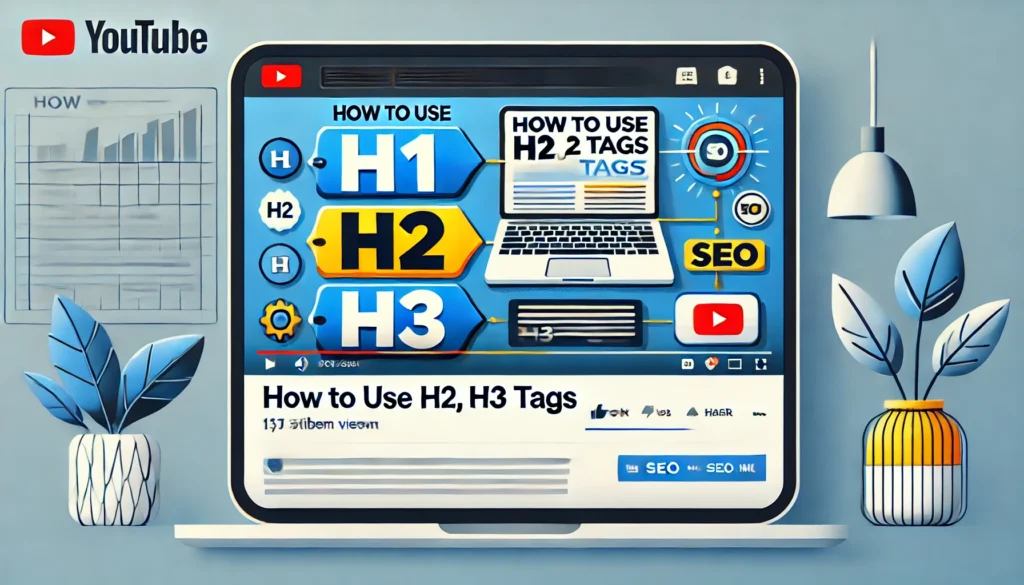Die richtige Verwendung von H1-, H2- und H3-Tags ist ein grundlegender, aber oft übersehener Aspekt der On-Page-SEO. Diese Überschriftentags strukturieren Ihre Inhalte und erleichtern sowohl Lesern als auch Suchmaschinen das Verständnis Ihrer Botschaft. In diesem Leitfaden erläutern wir die Bedeutung jedes Tags und wie Sie sie optimieren können, um das SEO Ihrer Website zu verbessern.
Warum sind Überschriftentags wichtig für SEO?
Überschriftentags (H1, H2, H3 usw.) sind HTML-Elemente, die die Überschriften und Unterüberschriften Ihrer Webseite definieren. Sie erfüllen zwei Hauptzwecke:
- Verbesserung der Lesbarkeit: Sie teilen Ihren Inhalt in übersichtliche Abschnitte und verbessern so die Nutzererfahrung.
- Steigerung der SEO: Suchmaschinen verwenden diese Tags, um die Inhaltsstruktur und Relevanz Ihrer Seite besser zu verstehen.
Lassen Sie uns nun besprechen, wie Sie H1-, H2- und H3-Tags effektiv einsetzen.
H1-Tags: Der Titel Ihrer Seite
Was ist ein H1-Tag?
Das H1-Tag ist die Hauptüberschrift Ihrer Seite. Es fungiert als Titel und vermittelt klar, worum es auf Ihrer Seite geht. Jede Seite sollte nur ein H1-Tag haben, um Verwirrung bei Suchmaschinen zu vermeiden.
Best Practices für die Verwendung von H1-Tags
- Integrieren Sie Ihr Hauptkeyword natürlich in das H1-Tag.
- Beispiel: So verwenden Sie H1-, H2- und H3-Tags für SEO.
- Halten Sie es kurz und ansprechend (50–70 Zeichen).
- Stellen Sie sicher, dass es das Hauptthema der Seite widerspiegelt.
Fehler, die vermieden werden sollten
- Mehrere H1-Tags auf einer Seite verwenden.
- Keyword-Stuffing im H1-Tag.
H2-Tags: Unterüberschriften zur Strukturierung von Inhalten
Was ist ein H2-Tag?
H2-Tags strukturieren die Hauptabschnitte Ihres Inhalts. Sie können sie wie die Kapiteltitel eines Buches betrachten.
Best Practices für die Verwendung von H2-Tags
- Verwenden Sie H2-Tags, um Ihre Inhalte in logische Abschnitte zu unterteilen.
- Integrieren Sie sekundäre oder LSI-Keywords, wo es sinnvoll ist.
- Beispiel: Die Rolle von Überschriftentags im Suchmaschinenranking.
- Machen Sie sie ansprechend, um Leser zum Weiterlesen zu ermutigen.
SEO-Vorteile von H2-Tags
- Verbessert die Inhaltsübersichtlichkeit für Nutzer und Suchmaschinen.
- Hilft Suchmaschinen, die Struktur und Relevanz Ihrer Seite besser zu verstehen.
H3-Tags: Unterabschnitte für weitere Details
Was ist ein H3-Tag?
H3-Tags werden für Unterabschnitte innerhalb eines H2-Abschnitts verwendet. Sie bieten detailliertere Informationen und helfen Lesern, tiefer in spezifische Punkte einzutauchen.
Best Practices für die Verwendung von H3-Tags
- Verwenden Sie H3-Tags sparsam, um die Klarheit der Inhalte zu bewahren.
- Integrieren Sie Long-Tail-Keywords natürlich, wo es passend ist.
- Beispiel: Wie man H3-Tags für SEO optimiert.
Tipps zur Strukturierung Ihrer Inhalte mit Überschriftentags
- Planen Sie Ihre Inhaltsstruktur: Beginnen Sie mit einem klaren Plan. Verwenden Sie ein H1-Tag, mehrere H2-Tags und bei Bedarf H3-Tags.
- Bleiben Sie konsistent: Achten Sie auf eine logische Reihenfolge der Überschriften (H1 → H2 → H3).
- Verwenden Sie Keywords strategisch: Vermeiden Sie Keyword-Stuffing, aber integrieren Sie Keywords natürlich in Ihre Überschriften.
- Verbessern Sie die Nutzererfahrung: Schreiben Sie Überschriften, die klar, beschreibend und relevant für den Inhalt sind.
Praxisbeispiel: Optimierung von Überschriftentags
So könnte die Struktur eines Blogartikels aussehen:
- H1: So verwenden Sie H1-, H2- und H3-Tags für SEO.
- H2: Warum sind Überschriftentags wichtig für SEO?
- H3: Wie Überschriftentags Nutzererfahrung und Rankings beeinflussen.
- H2: Best Practices für die Optimierung von H1-, H2- und H3-Tags.
- H3: Häufige Fehler, die vermieden werden sollten.
- H2: Warum sind Überschriftentags wichtig für SEO?
Diese Struktur sorgt für Lesbarkeit und SEO-Optimierung.
Fazit: So nutzen Sie H1-, H2- und H3-Tags für SEO
Die Optimierung Ihrer H1-, H2- und H3-Tags ist mehr als nur eine technische Anforderung – sie ist eine Chance, die Nutzererfahrung zu verbessern, die Lesbarkeit Ihrer Inhalte zu steigern und Ihr Suchmaschinenranking zu verbessern.
Indem Sie die in diesem Leitfaden beschriebenen Strategien anwenden, können Sie sicherstellen, dass Ihre Inhalte gut strukturiert, relevant und SEO-freundlich sind.
Bereit, Ihr On-Page-SEO auf das nächste Level zu bringen? Beginnen Sie damit, Ihre bestehenden Inhalte zu überprüfen und diese Best Practices auf Ihrer Website anzuwenden!

